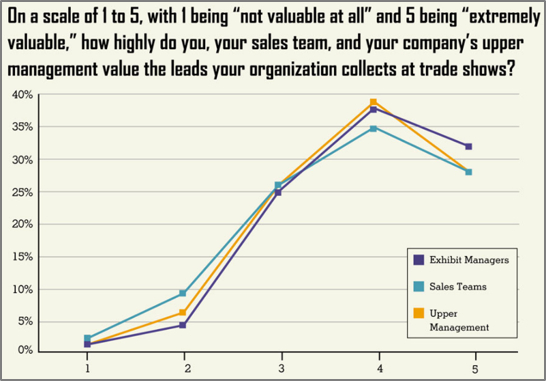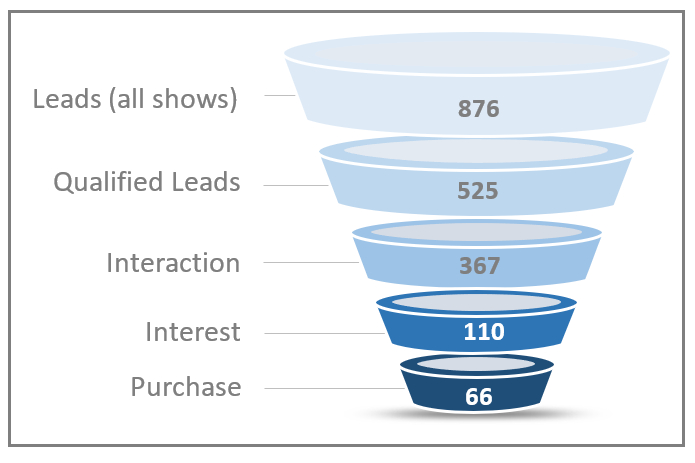Measuring the Impact and Success of Your Event Strategy: Why You Do What You Do

You’re a savvy marketer. Your company is at all the right events. You know how important post-show assessments are to determine Return on Opportunity (ROO) and success.
But do you also know how important it is to step back and look at the collective impact of your entire annual event strategy?
Specifically … How did the cadence of events throughout the year contribute to your overall strategic objectives? And how did you create opportunity for future financial gain?
Here’s what you need to know.
Year-end Strategy Evaluation: 3 Questions to Answer
Assemble the key players from your organization whose ongoing support of the events program is crucial, including executive team, sales, marketing, clinical, regulatory, etc.
“An annual review is the perfect time to raise awareness for your trade show efforts, internally,” says Robyn Davis, tradeshow strategy consultant at When I Need Help. “Involving key stakeholders in the process allows you to highlight the true value of your program and create buy-in for future plans.”
With your group convened, look at your marketing objectives for the past year, and ask your team these 3 questions.
Question 1: Did you attend the “right” events to be successful?
With your strategic objectives in mind, think about the shows you attended over the past year. Not your company’s specific participation (we’ll get to that later!). But rather: To what extent did each event give you the opportunity to be successful? Brainstorm a few key indicators for each objective, evaluate each event accordingly, and make comparisons. We use a simple, 5-point Likert scale, customized to our client’s specific information needs, to streamline the discussion and give numeric value to responses that may otherwise be subjective. Create your own tool, or download our free, Post-Event Assessment Tool.
Ideas to help your discussion:
a. Did any of the events fall significantly short in enabling your success?
No? That’s great! Move to the next question.
Yes? Brainstorm what may have contributed. Location? Conflicting events? Time of year? Educational content not applicable to existing or prospective customers?
Decide if you will participate the following year, being mindful of any negative consequences that may result if you choose not to (e.g., strategic partnerships, investor relations).
Also, try to flesh out if there are any “pet” shows that you feel forced to keep around, even though they clearly aren’t a good fit for your company. “When you have objective criteria to judge all shows against, it’s easier for the right shows to ‘win’ in your evaluation,” says Robyn.
b. Which event(s) allowed you to be most successful? And why?
Consider increasing your footprint in subsequent years through sponsorships, marketing opportunities, larger booth size, interactive stations, experiences, etc.
c. Are there shows you didn’t attend, but should consider adding to your event program next year?
Review a complete list of shows within your industry. Pay special attention to ones you haven’t attended before to determine if changes in your product line or commercial initiatives make them appropriate for your strategic efforts. For example, are you planning to expand into a foreign market? If yes, consider exhibiting at applicable international shows.
Question 2: Did your booth and activities exemplify your company well?
Booth size, visual allure and opportunities for customer engagement are important aspects to consider on an annual basis.
Size is important. Is your standard booth size still appropriate and adequate? Most start-up companies begin with a small exhibit footprint, such as a tabletop display or 10’x10’ booth space – and that’s ok! But as your company grows and your product becomes commercially available, the size of your booth should grow, as well. (Strive to be comparable in size to your biggest competitors.) There should also be adequate space for all you want to do, including product demonstrations, interactive stations, networking and hospitality. Attendees won’t want to gather in a congested area, so you’ll need to provide enough open space for them to engage with your staff and products.
Convey your brand. Your exhibit is a living representation of your brand and what your company stands for, including its mission, vision, values, products and services. Your booth structure and graphics should consistently and clearly convey your brand (think: messaging, colors, typography, imagery). And these should carry through to all marketing materials, giveaways, sponsorships, advertisements, pre- and post-show communications, etc.
Create opportunities for engagement. Over the past year, did you create welcoming environments? How were attendees encouraged to enter the booth and interact with staff and demonstrations? Consider if you need to add elements or make changes that will enhance visitors’ experiences in more meaningful, memorable ways.
Question 3: How well did your leads pan out?
Over 80% of exhibit managers, sales teams and upper management believe leads collected at trade shows are valuable. Unfortunately, most exhibit managers – as many as 65% – are unable to identify the percentage of leads that resulted in revenue (Exhibitor, 2015).
Start by aggregating the number of leads from all events over the past 12-18 months (stretching this exercise to 18 months allows for a more even playing field between shows held earlier in the year and those later in the year).
Next, capture metrics that align with your company’s pipeline categories (e.g., target, prospect, proposal). You can use a funnel (like I have here), a spreadsheet, or just a piece of paper.

In this example, 876 total leads were collected. Of those, 525 were identified as qualified leads. From the pool of qualified leads, there has been interaction with 367, interest was expressed by 110 of those, and so on. With this level of detail, you’ll have a better understanding of your success and how you may need to adjust efforts in the following year.
You may find value in linking this data to specific events. These metrics can then be useful in your discussion about which shows to attend next year.
Conclusion
Your company, objectives and event strategy are unique, but I hope you can take some of the tips provided here and make them your own. Regardless of whether you are completing your first or 10th year as an event marketer, whether your company is a small start-up or a Fortune 500 company, it is important to your ongoing success to critically assess the shows you attend, your booth and activities, and the fruitfulness of your leads.

Exhibitor Online, n.d. Lead time [online]. Retrieved January 27, 2020, from
https://www.exhibitoronline.com/topics/article.asp?ID=1880.
Becca Kiel is a strategic and tactical marketing communications professional with nearly 25 years’ experience. From comprehensive programs that build and enhance brand recognition, to equipping commercial teams for optimal performance, Becca excels at translating priorities into marketing campaigns that achieve corporate and commercial goals. Becca is skilled at developing and implementing event-based marketing strategies, including medical conventions and trade shows, sales trainings, investigator and KOL meetings, special events and webinars/online training.
